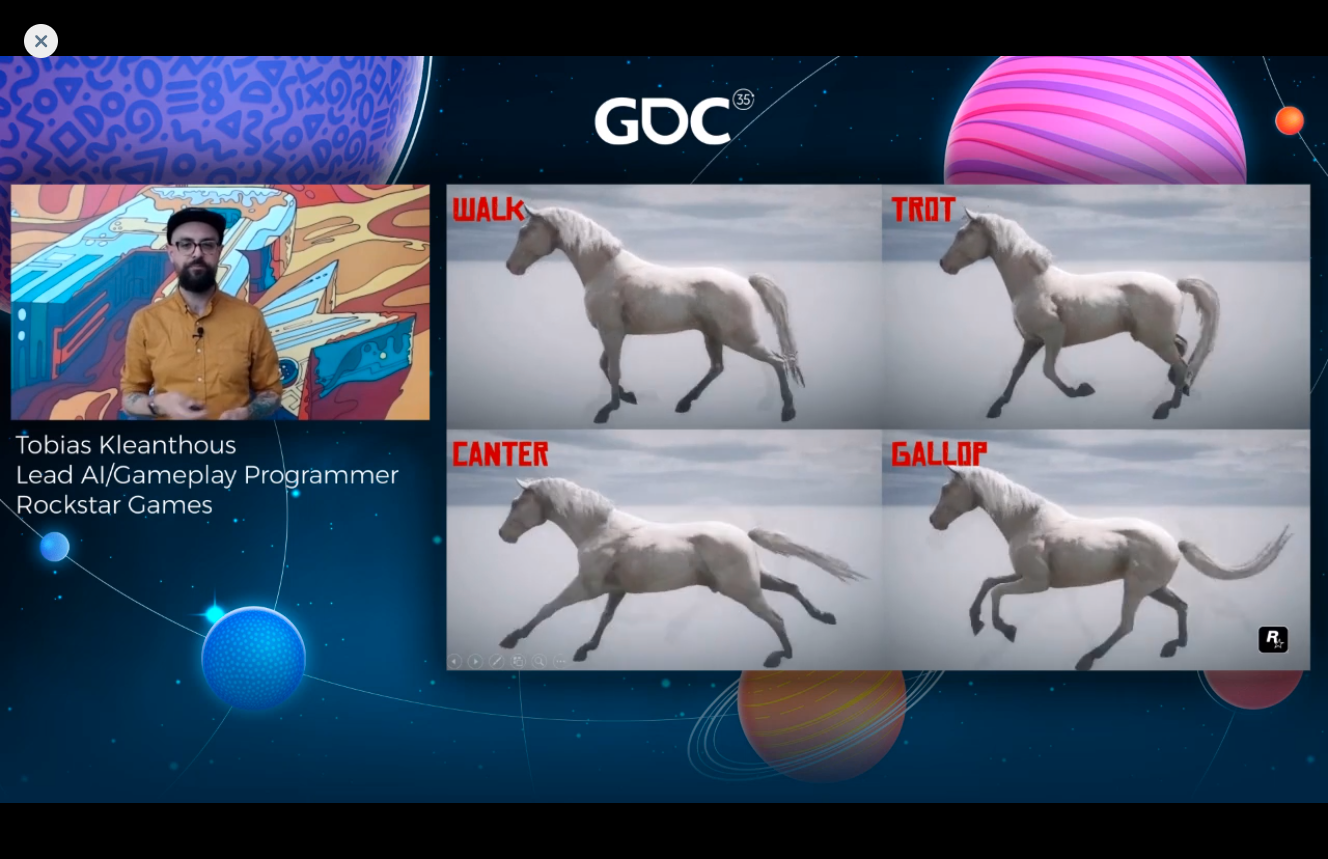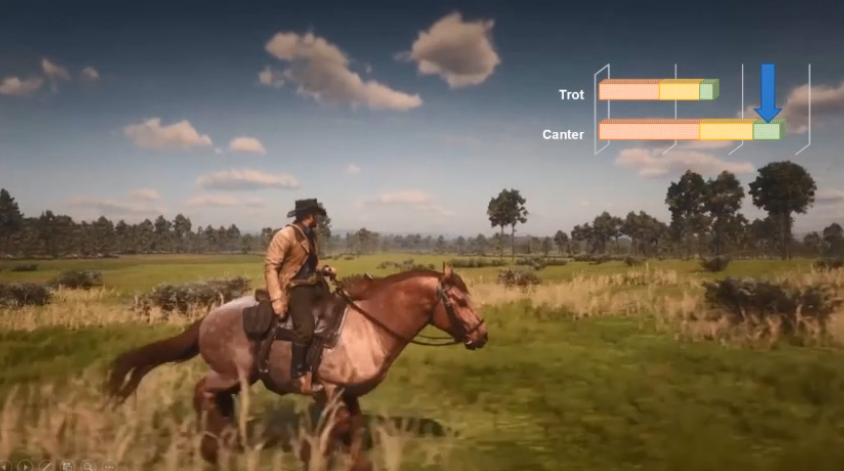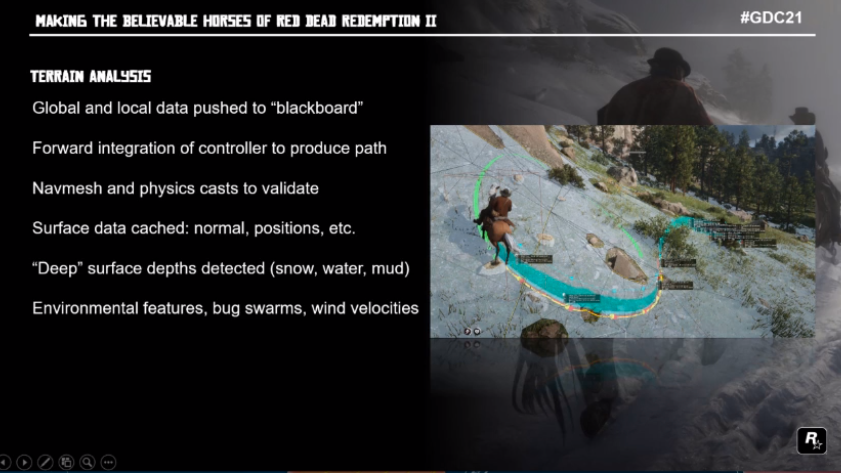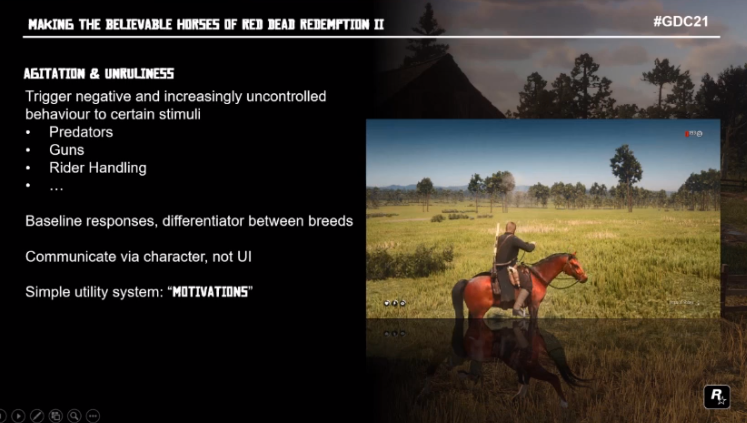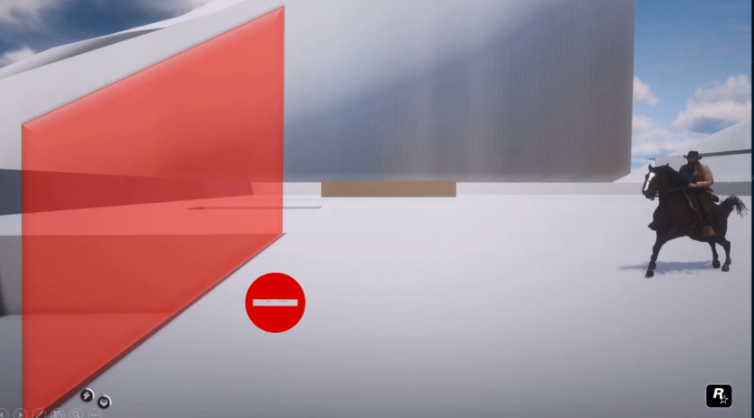The mind-boggling work that went into Red Dead 2's incredibly lifelike horses
Rockstar explains what goes into making these horses the best around.
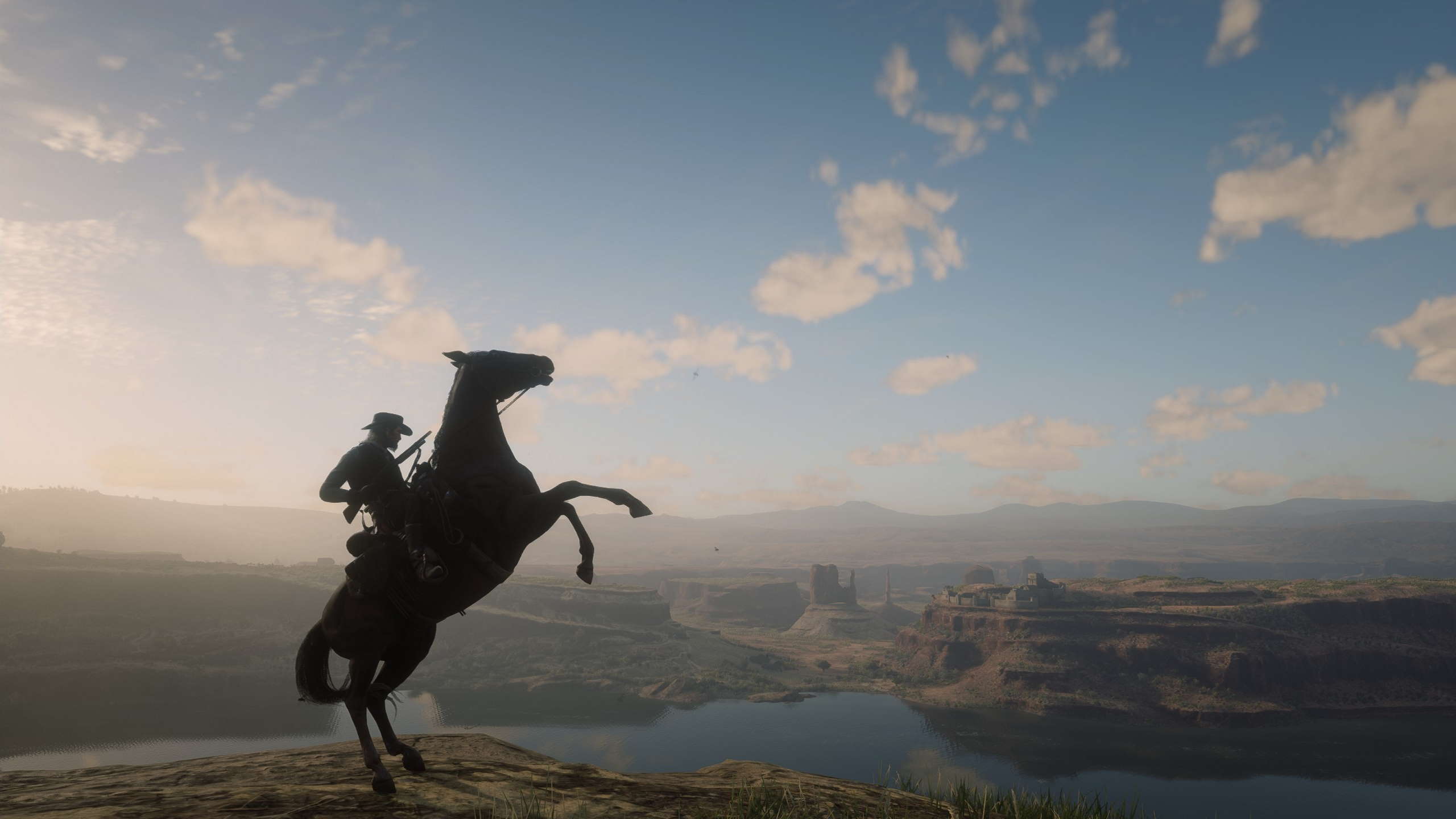
GDC 2021 is currently underway, and as part of it Rockstar North's Tobias Kleanthous delivered a talk called 'Making the Believable Horses of 'Red Dead Redemption II'. Given that Red Dead 2's amazing horses are a frequent topic of discussion during PC Gamer editorial meetings, I had to watch.
Horses are integral to the Red Dead 2 experience, and far more than a mode of transport. Rockstar's stated objective was to create "a trusted friend with whom a deep connection is forged over the course of [Arthur's] story." Kleanthous began by talking about how the goal was to live up to the memories players had of the horses in Red Dead Redemption, rather than using that system again, and creating animals that could play "the 'best supporting' role to Arthur Morgan's lead."
The team began by unifying what had been disparate movement systems for humans, animals and horses, with the core principle that Red Dead Redemption was a more slower-paced and grounded world than GTA. Kleanthous then showed the team's first cobbled-together animated horse, which amusingly enough already looked better than the finished horses in most other games. He himself posed the question of why Rockstar didn't just ship this, and answered that it was too functional. It had discrete speeds, no range, no variation, a limited range of movement, the turning was stiff, and it had inconsistent transitions.
Well, I guess now you mention it…
"It was functional, but missing something," Kleanthous said. "It's not a car, it's not a bike." The question was "how to get livelier performance, and by that I mean the behavioural implications and personality from movement. We wanted to make it more believable."
Rockstar started capturing footage of real horses in Scotland, with a video example showing how a real horse, for example, before turning would side-step and then lean into the turn. Lateral movement became a key part of the horse design from that point, a movement essential for light turning, and, Kleanthous added, one of the most difficult features to get right.
Another video showed a horse pivoting on its front feet, with them positioned under its chest, and turning laterally rather than vertically. There were clips of dressage which would be incorporated into the horses' gaits. Kleanthous talked about how the team had also added input lag to make it feel like Arthur is controlling an animal rather than a vehicle, and how these elements were coming together into the game's "anatomy of drift".
Keep up to date with the most important stories and the best deals, as picked by the PC Gamer team.
Though the team began thinking about an 'automation' approach to animations, some were sceptical about whether it would work. The idea is essentially that, rather than Red Dead's horses having a load of bespoke one-off animations for each different gait or speed, the team would create thousands of smaller animations which would be assembled on-the-fly in-game. The pool is narrowed-down based on the horse's surroundings, speed, encumbrance, mood, and so on, then stitched-together. This was apparently incredibly tough to get working right but, once they cracked it, ended up being applied across the game much more widely.
There are four basic gaits and speeds of Red Dead's horses: they can walk, trot, canter and gallop. This gets rid of the discrete speeds problem of the more functional early horse, because of the freedom to cycle gradually through them. Initially Rockstar tried 'one shot' transitions, one-off bespoke animations, but these introduced problems: it was difficult to control speeds when inserting them, the foot cycle defined the transition, and ultimately the transitions weren't smooth.
So Rockstar moved towards a system of continual acceleration and deceleration rather than one shots, continuous cycles or varying speeds and non-fixed transitions. This concept became known as the 'Don't stop moving' principle internally, and even applied to stopping and starting. When you begin to slow down on one of Red Dead's horses, it moves into and keeps deceleration cycles running but waits for an input that can instantly transition that into an acceleration cycle. It almost wants to keep going, keep moving. The idea is to make it look like you're not necessarily controlling the horse, but it is trying to respond to you.
There was also some involved chat about how canter and gallop are three-beat gaits, which means the intervals between front foot strikes are irregular: that is to say, four-legged movement is different from bipedal movement. Another interesting bit of trivia is that the riders have a simple animation loop that plays as the horse moves, but the rider (and any passenger) is then 'fed' new animations based on the horse's animations, and their rhythms are blended together though never on a 1:1 basis.
The next element layered atop these remarkable virtual creations is environmental awareness. Rockstar began with the core idea that difficult terrain ought to take its toll, and this would be sold to the player through visual, feel and speed changes. The fastest horses in the game would move at around 40mph, fast enough that things can go wrong, which made it crucial that as an independent AI character it had instinctive self-preservation instincts, and would make movement decisions of its own that will assist (or hinder) the player.
Kleanthous showed a clip of a horse walking through the snow, and explained all the variables that were going into that particular animation. The game is using the information of what type of terrain the horse is on, the depth of that terrain, the weather conditions, and from these selects a bunch of bespoke animations that suit those conditions—the examples given here were the addition of a swish to the horse's tail, reflecting the cold and the snow, and Arthur adjusting his hat because of the wind—and 'builds' on-the-fly an animation cycle reflecting all of these inputs.
This will also have elements of acceleration and deceleration built into it in those overlapping cycles, such as for example when you're going through water. A little water sees little movement penalties being applied, and as it gets deeper the horse's movement is more dramatically slowed-down, and increased player input is required to offset some of this, emphasising the 'effort' the animal is going through.
The horse's AI focus on self-preservation also helps to make the player's navigation less stressful: that is, a horse doesn't 'want' to run into a tree, even if the player's guiding them towards it. So Red Dead 2's particularly knotty terrain like trees or big rocks are marked-up for the horses which use this information and their lateral velocity to naturally avoid them.
Kleanthous could not quite contain his rightful pride at the next element of Red Dead 2's horses: how they stop at the edges of cliffs. Rockstar developed a technique it calls 'stop matching' whereby the horse, upon approaching a cliff edge, begins extracting certain animations required, calculating where it wants to go and the best possible place to begin stopping and inserts that animation at the right point into the normal animation cycle. Part of this is that all the cliffs in Red Dead 2's world were manually marked-up by Rockstar's artists (demonstrated in the above image), something that Kleanthous says "in the future" they'd like to rely less on. Red Dead 3 confirmed baby, I knew I watched this for a reason.
So we come to the horse's personality. An amused Kleanthous observed that a lot of the work was done on negative interactions, as the team believed the more positive relationship with the horse's personality would be constructed over the 'normal' riding experience and travelling the world. So for example, in a clip Arthur slaps a horse on its rump, and gets kicked in the head and killed, which Kleanthous notes "is a memorable moment".
Shooting guns, predators, bad riding, all these things agitate the horse, with different breeds having different baselines. More agitation means more physical motion, eventually building to a pitch where the horse is trying to throw the rider off, and the animal creating more impediments for the player.
The horse will sense predators like bears in the world before the player does, and grow agitated, and the horse will even stop and jostle to encourage the rider to turn around. If you don't and insist on trying to force it towards a dangerous animal, the horse tries to escape itself—that self-preservation instinct again—and will throw the rider off if possible.
Oh, and all of Red Dead's animals have a toilet motivation, which builds until they do a poop.
Feedback encourages the player to respond to the horse and also creates personality: through animations showing low health and low stamina, with commensurate decreases in performance which, as noted on one of Kleanthous's slides, results in a "sad horse :(".
Red Dead shipped with 19 breeds—further adding to the complexity of all this—loosely grouped into four categories and all differentiated by variations in their size, acceleration and deceleration cycles, preferred speed ranges in different gaits, how they turn, how their strength offsets penalties and terrain, what they're carrying, what equipment's on them, and various other stat trade-offs in order that there was not, and I quote, "one true horse to rule them all".
I should say that, as this was a talk with some light technical elements to it, there are parts of what Kleanthous said that were beyond me. His explanations of some of the maths was probably quite good, but I was so bamboozled by certain slides I'm not going to try and explain them for fear of mangling the team's work.
Kleanthous said he was delighted to see people at release judging the accuracy of Rockstar's dressage animations, noticing how much some horses pooed, and complaining about the big dumb horses that always seemed to get in the way. He should sit-in on some of our meetings and hear our EIC talk about the musculature of their haunches.
So yeah: the horses in Red Dead Redemption 2 do look absolutely amazing, and all of the above is why. The scale and complexity of the system Rockstar built is awesome and ingenious, and its developers' ability to start from first principles and keep those at the forefront of the process is why it makes some of the best games in the world. Next time you load up Red Dead Redemption 2, maybe just take a minute to chum with your horse, give it a bit of a grooming, show that thing some big love. Because the people who made them sure did.

Rich is a games journalist with 15 years' experience, beginning his career on Edge magazine before working for a wide range of outlets, including Ars Technica, Eurogamer, GamesRadar+, Gamespot, the Guardian, IGN, the New Statesman, Polygon, and Vice. He was the editor of Kotaku UK, the UK arm of Kotaku, for three years before joining PC Gamer. He is the author of a Brief History of Video Games, a full history of the medium, which the Midwest Book Review described as "[a] must-read for serious minded game historians and curious video game connoisseurs alike."
